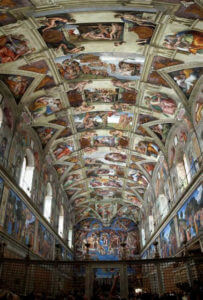Virtual Visits: Michelangelo’s Sistine Chapel Frescoes at Vatican City
360° View of the Sistine Chapel in Vatican City in the time of social distancing

One of the most popular sites of the Musei Vaticani complex, the Sistine Chapel stuns its visitors with Michelangelo’s frescoes and stories of the sacred rituals, such as Papal Conclave of the Cardinals conducted within its walls from 1492. Completely restored in the years from 1979 to 1999 to its original vibrant colors, the Chapel was visited daily by more than 20,00 people. Pope John Paul II said about the chapel that “The truth of our faith speaks to us here from all sides”.
As humanity stays at home in the face of the global coronavirus pandemic, it is particularly uplifting to revisit albeit virtually the historic places that withstood prior global disasters like plague epidemics and the wars. The Musei Vaticani offers a virtual tour of the Sistine Chapel with closeups of frescoes and an unobstructed view of the room without any distraction by the guards or the unavoidable neck craning to see the ceiling.
The Sistine Chapel in the Vatican was built in 1477-1480 by Pope Sixtus IV for whom the chapel is named. In fact, the old Cappella Magna that stood on that site from the mid-14th century was restored by the best artists of that time like Sandro Botticelli, Pietro Perugino, Pinturicchio, Domenico Ghirlandaio, and Cosimo Rosselli. From that time until this day the Chapel is used for special ceremonies of the close circle of the Pope and as a place where the Papal Conclave of Cardinals meets to elect a new Pope.
Interestingly, the dimensions of the Chapel are the same as the Temple of Solomon according to the description in the Old Testament, the Book of Ezekiel. The Temple of Solomon was the first temple built by the Hebrews in 832 BCE under King Solomon. It was destructed by Nebuchadnezzar II after the Siege of Jerusalem of 587 BCE.
Michelangelo spent from 1508 through 1512 on painting the ceiling of the Chapel on the commission by Pope Julius II. Because at the time Michelangelo was preoccupied with sculptures and was reluctant to commit to such an enormous undertaking, Pope Julius granted him full freedom in selecting the scenes and figures to paint thus convincing him to take on the project. The resulting frescoes are considered to be the triumph of the artistic expression in Western civilization. The ceiling is populated with more than 300 figures starting from Christ’s ancestors including Adam and Eve, the scenes from the Garden of Eden and the Great Flood all the way to Christ’s followers, prophets, and sibyls.
Michelangelo’s mastery brings us the “faces of our time: anxiety masked by domesticity, women at work at household duties, men staring out blankly at an opaque fate” in the words of A.Gopnik in The New Yorker review of the exhibit of the photographs of the frescoes at the Oculus in New York City.
Do your best imagining yourself walking through the grand doors of the Chapel by taking the virtual tour. And while it’s definitely not the same as being surrounded by the great art at the place for which it was created, you can still connect with history and art. Their meaning may even become more apparent and better understood.
Stay in the know about future live and virtual events and offers by subscribing to ARTS-NY newsletter Subscribe